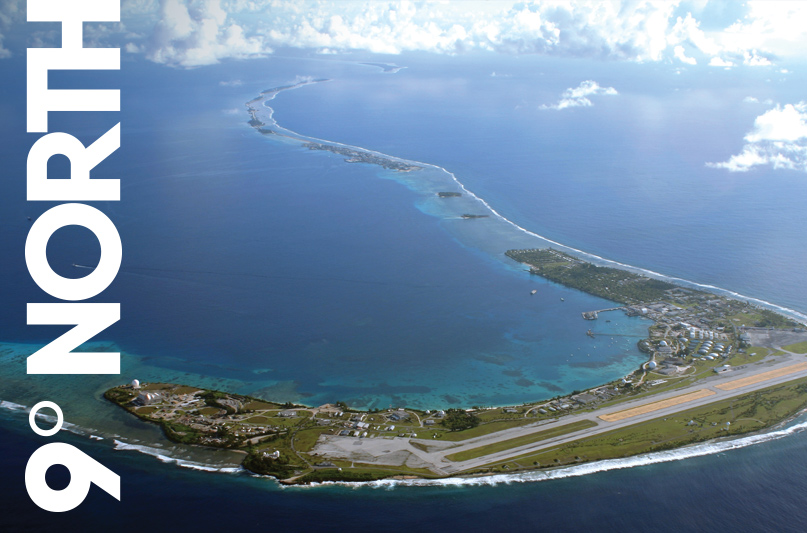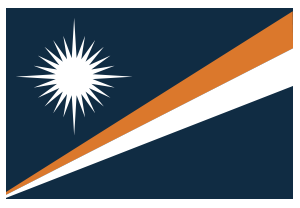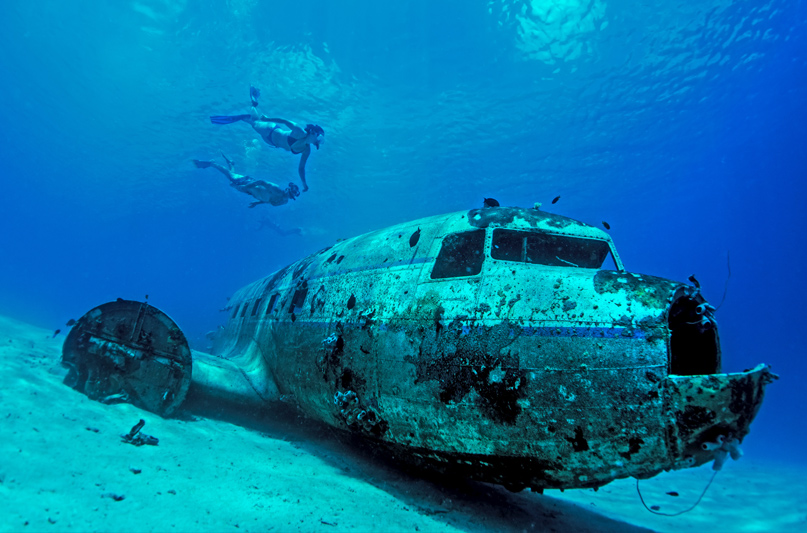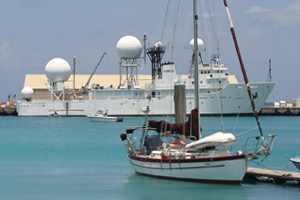
 Most find the Marshall Islands to be a hidden escape, however the sail out to this Pacific paradise is anything but easy. It’s so challenging in fact that sailors often cross their fingers in hopes that an on-island vessel is up for grabs. Others pitch in in to help with upkeep of other’s vessels in exchange for use. But only a select few actually brave the open seas of the Pacific to visit this tropical escape. West Coast locals Tim and Cindy Cullen and their two cats did just this as first-time open ocean sailors – a story I was eager to hear upon my arrival to the RMI.
Most find the Marshall Islands to be a hidden escape, however the sail out to this Pacific paradise is anything but easy. It’s so challenging in fact that sailors often cross their fingers in hopes that an on-island vessel is up for grabs. Others pitch in in to help with upkeep of other’s vessels in exchange for use. But only a select few actually brave the open seas of the Pacific to visit this tropical escape. West Coast locals Tim and Cindy Cullen and their two cats did just this as first-time open ocean sailors – a story I was eager to hear upon my arrival to the RMI.
“Iakwe and welcome to Kwajalein” says the flight attendant in Marshallese as I step off my United flight into 80 degrees and palm trees. At 2,300 miles southwest of Honolulu, Hawaii, and 2,000 miles southeast of Guam, it’s safe to say I’m in the middle of nowhere. I pick up my clearance badge, a requirement for those visiting and living on the Ronald Regan Ballistic Missile Defense Site on U.S. Army Garrison Kwajalein Atoll (pronounced “Kwah-juh-lynn”) and hop on a beach cruiser bicycle to head south for a happy hour brew with the Cullens at the Kwajalein Yacht Club (KYC). With very few accessible cars, the locals rely primarily on bikes to navigate the 3-mile by ½-mile island. It’s good to be back home in this country rich in seafaring of all tides and tales.
After introductions, we settle for a spot under an Australian pine at the beach’s edge. The Outrigger Canoe Club launches for a sunset paddle while Tim dives into the couple’s cruising story. Tim and Cindy moved to Redmond, Washington, from California in 1994 and purchased a 23’ North American Spirit for $2,500 in which they embarked on a two-week sail through the San Juan Islands.
“That was a turning point for us,” recalls Tim, “it sold us on the whole cruising idea, but we needed a bigger boat.” Their next purchase was a 31’ Mariner, and they eventually settled on their 36’ vessel, Masquerade. After selling their home, they sailed around the Northwest, fixing odds and ends aboard and preparing for long voyages ahead.
“We had a pact,” said Cindy, “if one of us can’t stand cruising, we still need to give it a year, then if it’s still unpleasant for either one of us, we’d sell the boat, because our marriage was more important than cruising.”

The Cullens hit the books and took classes in US Coast Guard Sailing, navigation and celestial navigation, HAM radio (Amateur Radio), sail repair workshops at Port Townsend Sails, rigging and splicing with Brion Toss Yacht Riggers, EMT courses, and more. They hauled Masquerade out, crawled around the bilge, climbed the mast, rigged her, and completed most of the drudgery themselves.
“You really don’t know your boat till you do all of that,” explains Cindy. While in Washington, Tim and Cindy joined the Puget Sound Cruising Club where they practiced their boating skills with like-minded individuals. Here, they met many of their year-round sailing friends. Every weekend the club cruises various areas of the Pacific Northwest. They recommend this group to anyone looking to gain sailing experience or long-term boating buddies.
During Masquerade’s final year in Washington, they enclosed the cockpit, bought a dorm fridge, purchased a camp stove and convection microwave, rebuilt the icebox into a fridge/freezer, and more. They also created covers for the galley stove and sinks for more food prep space–vital for small cruisers like this one.
Tim, previously a software developer for Vizio, and Cindy, once a stay-at-home mom and a volunteer for Puget Sound Blood Bank, left Seattle with a Glacier Bay permit and no final destination in mind. They factored in three to five years before they’d return to work. In April 2006, Tim and Cindy set sail with their kitty, Willie, in an upwind battle to Glacier Bay before continuing down to California and Mexico. Tim, Cindy, and Willie cruised in and out of small rural towns and pristine waters, living by the winds and rolling with the tides. In the winter, they’d head south to the Sea of Cortez and back north when hurricane season hit in the summer.
Four years and another cat later (Blue “Boo-Boo”), it was time to return to work. Tim applied to a software developer position in the RMI he discovered through a friend of a friend. He was offered the position with Flight Safety on the Ronald Regan Ballistic Missile Defense Test Site in Kwajalein Atoll. Instead of boarding a flight to Hawaii and an additional five-hour flight to Kwaj, the Cullens began preparing for their first open ocean voyage.

Kwajalein’s purpose as an army missile defense base is to track and monitor test missiles launched from California to Kwajalein Atoll’s lagoon. If the missiles stray off their path and possibly endanger people and/or property, Flight Safety is responsible for the missiles’ destruction. Tim helps maintain the system and the signal that instructs the missiles to destruct.
The Cullens’ vessel was already cruise-worthy from their Mexico expeditions, so only minor adjustments were needed before departing. Cindy had to find someone to host the Southbound Net online community for her, the hull had to be painted, and Tim needed a physical. Cindy pre-cooked, vacuum sealed, labeled, and froze a few meals for their voyage in addition to freeze-dried camping meals, nuts, cheese and crackers. After reviewing their pilot charts, they “just went for it,” says Cindy, perhaps a little too soon in hindsight, if you ask them now.
“Because we had the job waiting, we felt kind of pressured to leave and probably left a day or two before we should have,” explains Tim. He continues, “Schedules are never a good idea for cruisers. It’s always better not to have a schedule that could force your decision on something… it was pretty rough the first couple days out.” After the storm came the calm, and after the calm, the trade winds kicked in.
The shipping routes offered companionship the first few weeks, but they didn’t see another vessel or speck of land for the two weeks following. The couple thought they would be driving each other insane by this point, but it was the complete opposite. They sailed in shifts with one person always on watch and the other off with a few hours of overlap. Tim listened to podcasts, read books, or practiced Spanish to keep his mind occupied. Cindy updated the ship’s log and participated in the Pacific Seafarer’s Net – a free daily check-in service for recreational ocean-crossing vessels.
A few storms hit the north Pacific, causing agitation in the seas on their journey. They faced an almost constant side swell, which made for a rocky voyage. Items they never had to maintain before suddenly needed tender love and care.

Masquerade sailed past Hawaii (because of cat quarantine issues) and onto Johnston Atoll for a few nights. Once a military storage site for chemical weapons, Johnston Island is now a wildlife refuge. 60 Minutes claims this island once had enough chemical weapons to destroy every living creature on earth multiple times. In 1982, incinerators burned the chemical weapons out of existence. Foundations of roads and buildings remain buried in the brush under overgrown foliage; an eerie reminder of what once was.
Here, they were finally able to sleep in the same bed and enjoy Baileys in their morning coffee, but they didn’t expect to find five emails from NOAA about an approaching tsunami the following morning. They weighed their options: 1) The pass out of the lagoon extended for miles. If a tsunami hit, their vessel would be coral-ridden. 2) Tie up at the dock, but even that wasn’t safe. So that left 3) Anchor in the lagoon and hope for the best. Luckily, because of atolls’ geography, tsunamis are a rarity because they need a gradual incline to slowly build the destructive wave. Atolls are rims of volcanoes, their slopes are steep, allowing virtually no surface area for a wave to build to that degree. The tsunami manifested as a 1.5’ surge that submerged a few dock ladder rungs. With that adrenaline rush under their hull, it was time to sail off on their last leg.
Forty eight days later with Military Orders in hand, the Cullens arrived to Kwaj, settled into their complimentary house, and eventually hauled Masquerade out for repairs. Luckily, the vessel is in decent shape after its ocean voyage and required no major repairs, but the strain of a trip like that requires some attention. Tim and Cindy are making Masquerade seaworthy once again, mainly ensuring the hull, sails, and rigging are in decent shape. Other repairs on the docket are a failing electrical system, updating refrigeration, and fixing the leak in the fuel tank.
At the club, the sun is setting and our beers are almost dry. We talk about their lifestyle and tips for ambitious cruisers who may want to follow in their footsteps. One significant aspect of boating in the RMI is the difficulty to obtain parts. Most parts must be ordered online and can take up to a month to be delivered. Some items can’t be shipped out at all. Tim had difficulty obtaining something as simple as acetone. He says he “always has four to five jobs running at once because when you get stuck, you move on to the next one until you can get the part for the project you need.”
The constant wind and warm water make sailing in the RMI fantastic almost all year. “It’s a big leap [in the RMI] compared to the Northwest,” cautions Tim. “You have to go from lagoon sailing to open ocean sailing with trade winds.”
In the Northwest, there is a stairstep approach you can take with sailing. One can begin on a lake, then move to the Sound, then the San Juans, the Strait of Juan de Fuca, and onto Vancouver Island, slowly and incrementally increasing your skills as you feel fit. He looks back on races like Swiftsure with fond memories. “That was really good experience for doing overnights and being on a schedule, and also sailing a little outside your comfort zone.”

Cindy urges potential voyagers to consider the difficulties of owning and maintaining a boat in the Marshall Islands. The base isn’t as boat friendly as it once was; the climate is harsh, the anchorage isn’t very protected, and getting your boat hauled out is difficult. However, “if you’re cruising through and don’t plan to live on Kwaj very long,” explains Cindy, “or just want to cruise in the Marshall Islands, the islands and people are wonderful.”
I asked what’s next for the Cullens. Their plan is to hang in the islands for a while before sailing south across the equator and possibly on to New Zealand and Australia before Japan. Eventually, they’ll sail up to the Aleutian Islands and down to Orcas Island where they’ve recently purchased a house to live in upon their return from Kwaj.
For those looking to follow in the Cullens’ wake, take advantage of the many boating outlets available in the Northwest that will prepare you for a future ocean crossing. From all-weather sailing, racing, endless boating classes, and a savvy and supportive seafaring community, with a little dedication and the push of a dream, who knows? Maybe we’ll be trading stories at the KYC one of these happy hour evenings. Until then, the open ocean awaits, fellow sailors. Hoist the mainsail, batten down the hatches, and get to it!
